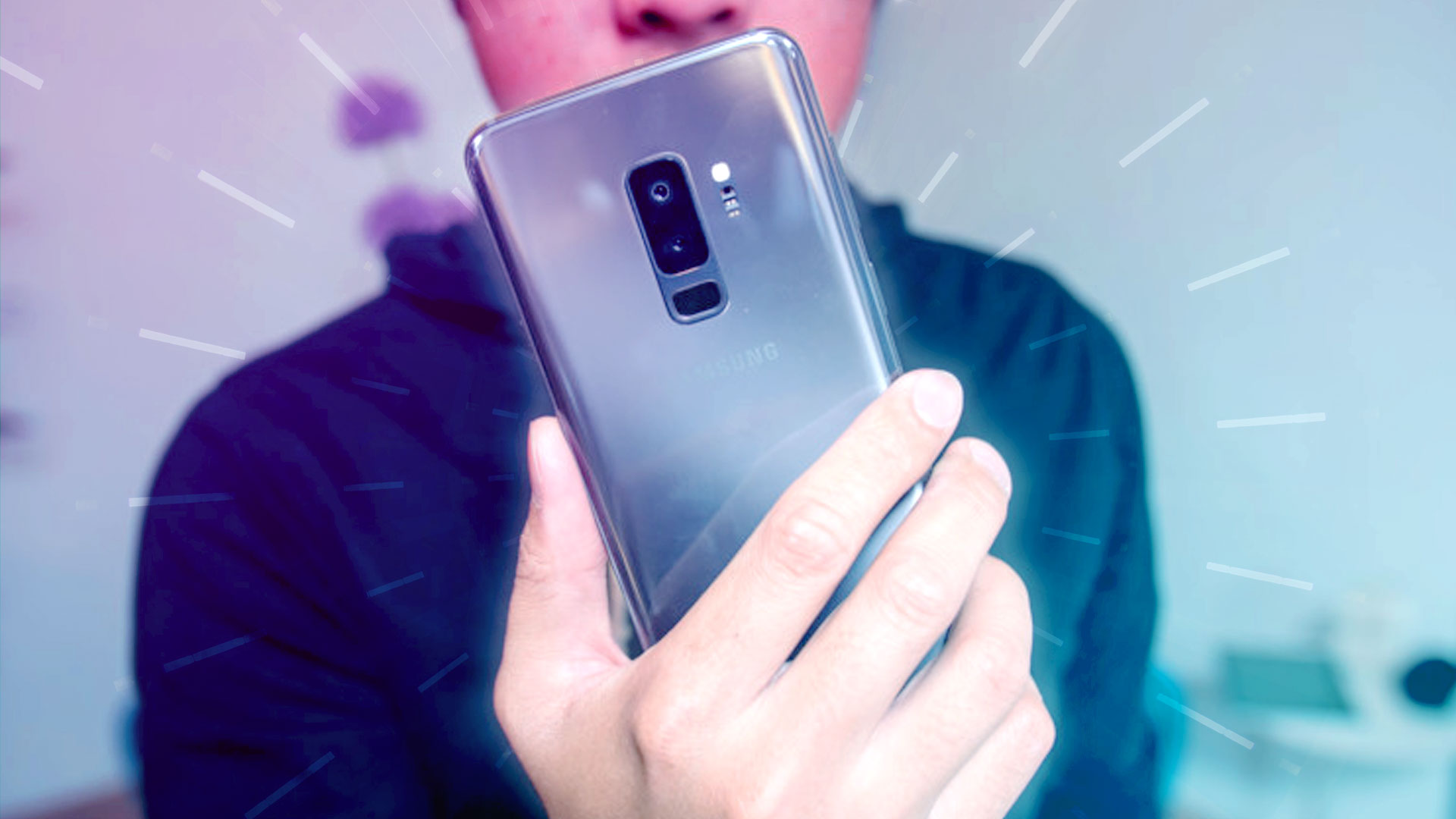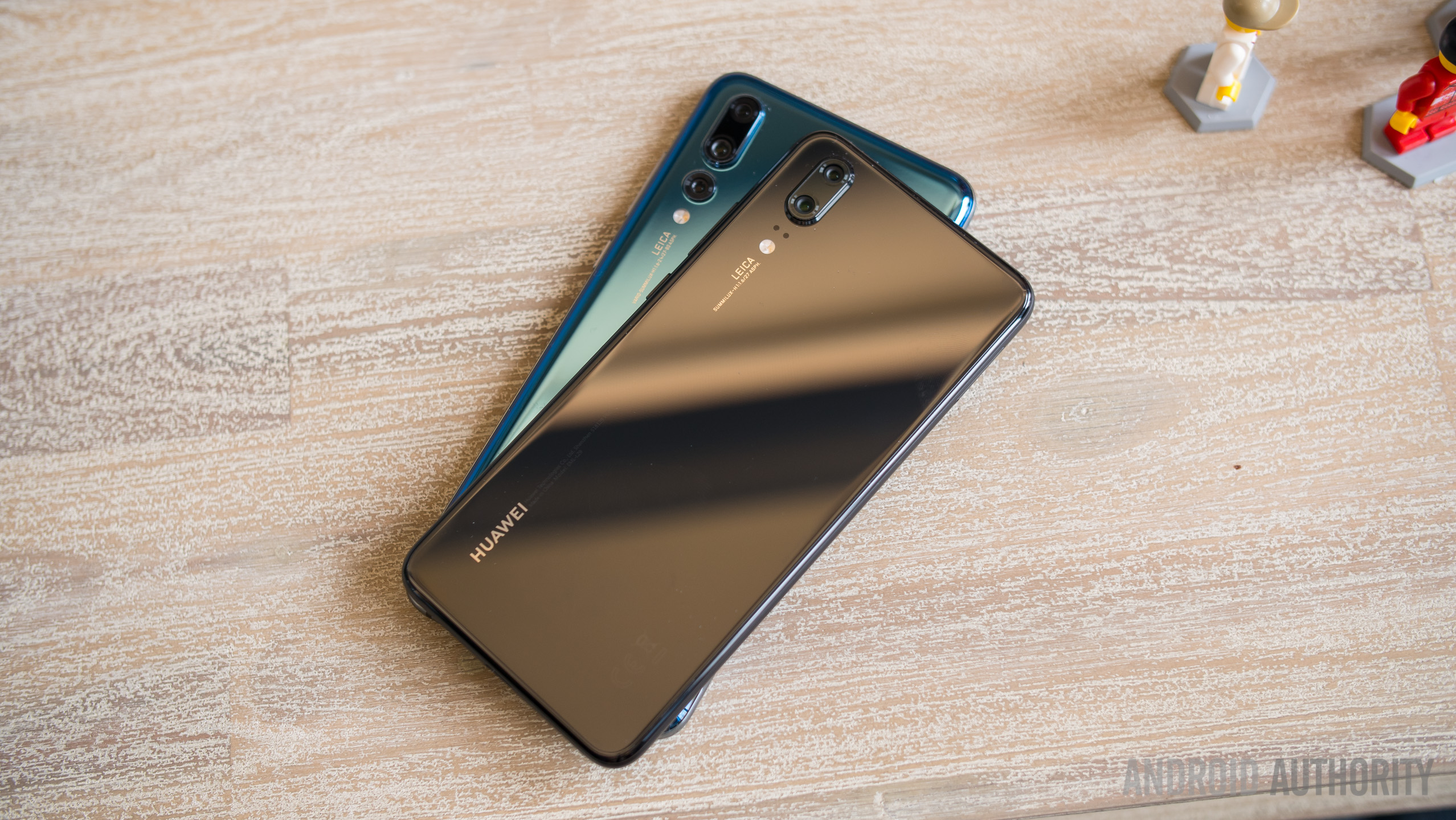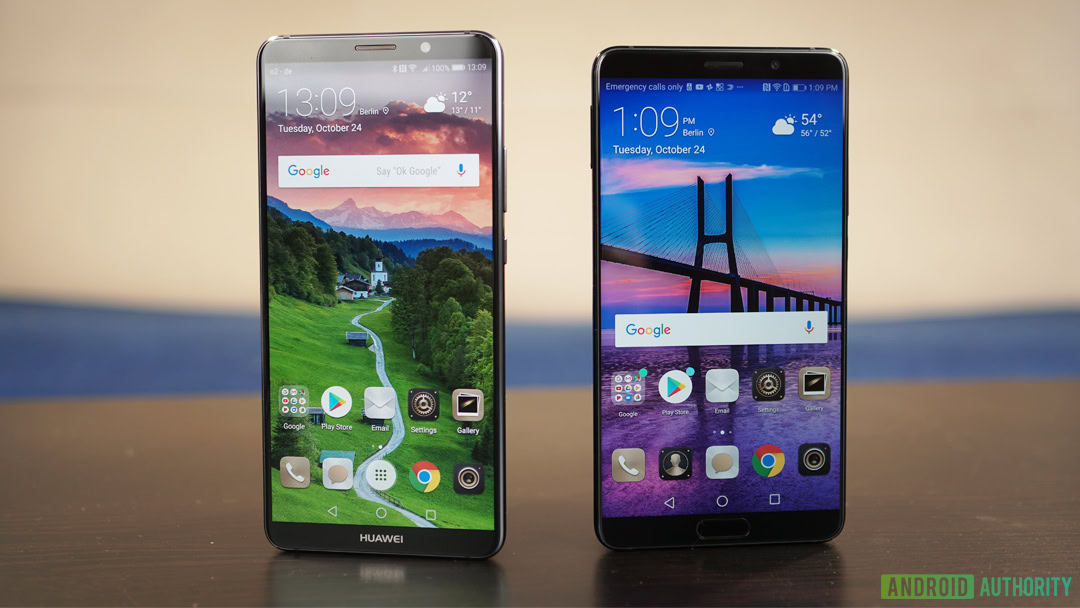Samsung took a more reserved approach with the Galaxy S9, bringing only a handful of notable tweaks to its 2018 flagship from the S8 lineup. Huawei, on the other hand, has just launched a new phone that looks almost completely different from its predecessor. How does the best from Samsung compare with the best from Huawei? Find out in this comparison of the Huawei P20 Pro vs Samsung Galaxy S9.
Related: Huawei P20 and P20 Pro hands-on | Huawei P20: Everything you need to know
Despite the all-glass construction, the aesthetics of both devices couldn't be more different. While Samsung was able to bring some freshness to the Galaxy S9 lineup with the new lilac purple color, much of the phone is unchanged from the Galaxy S8 lineup. There are some notable improvements this time around though — the fingerprint reader has been moved to a much more convenient spot, and the Galaxy S9 Plus gets a secondary telephoto lens. Aside from that, the changes to the Galaxy S9's design are minimal.

Color has always been one of Huawei's fortes, as evidenced by the previous partnership with Pantone for the P10 lineup. But the P20 takes it a step further; Huawei has thrown in some modern design moves and created something we haven't seen before: a two-tone smartphone. The twilight edition of the Huawei P20 Pro features a gradient that smoothly transitions from blue to purple. We wouldn't blame you for calling it a unicorn colorway. There are other colors available, but the twilight edition phone is definitely the eye-catcher of the bunch.
The P20 Pro's three rear cameras will definitely turn some heads.
The twilight color isn't the only thing that will turn heads — the P20 Pro also features three rear cameras. Before we talk camera features though, just note how all of the elements on the left side of the phone are lined up on the side. It's a small thing, but one that makes the back side of this phone look unlike any other we've seen.

Huawei has decided to keep the fingerprint sensor/home button on the front of the device, right below the screen. We were told that this would help keep some continuity between P-series iterations, but the trade off is that there is a little more extra room under the display. It doesn't add too much to the screen-to-body ratio though, even though the P20 and P20 Plus' Full HD+ screens have an 18.7:9 aspect ratio. The larger Pro model has a 6.1-inch screen compared to the Quad HD+ 6.2-inch panel of the S9 Plus, while the standard P20 and S9 both sport 5.8-inch screens.
The higher resolution of the Galaxy S9's display might be a draw to some, but in our time with Huawei's past devices, Full HD+ still gets the job done. Of course, the main difference in display separating these two are the curves on the sides of the Samsung — the Infinity Display helps with in-hand feel and brings with it a couple of extra features like the Edge UX. Ultimately, it'll be your choice if the unique screen experience on the Galaxy S9 is worth more than the fancy twilight colorway on the P20.

Samsung and Huawei's software versions look pretty different from one another; these are two of the more polarizing versions of Android out there. Huawei's EMUI is one of the more fully-featured Chinese Android interfaces, with plenty of customization options like the ability to take away the software navigation buttons, utilize the built-in theme engine, and more.
These are two of the most polarizing versions of Android out there.
It does fall a bit short in one area though — Bixby, Samsung's voice assistant. Bixby is Samsung's increasingly capable AI assistant, though it comes on top of the already baked-in Google Assistant. Plenty of Samsung apps add redundancy over the Google equivalents, though the same could be said for some Huawei add-ons. But where Samsung does have a foothold is in customization — so much of Samsung's UI can be personalized. We'll spend more time with EMUI on our review units and see how much more Huawei packs in to its software this time around.

Under the hood, these phones benefit from their current release cycles as the Snapdragon 845 powers every device in this comparison. The Galaxy S9 Plus and P20 Pro both get bumps up to 6GB, though the P20 line has more built-in storage — 128GB compared to the Galaxy S9 line's 64GB. The P20 does not have expandable memory though, while the Galaxy S9 line does. The P20 line doesn't have a headphone jack either, while the S9 does.
Where the P20 line might have the S9 beat is in the battery department. Considering the fact that the P20 has a Full HD+ display, that will make its 3,400mAh battery last much longer on a single charge. Huawei was able to cram in a big 4,000mAh battery in the P20 Pro, which is a lot for a phone that is packing a lower resolution screen. This is compared to the 3,000 and 3,500mAh cells on the S9 line.

The cameras are probably the most contentious part of this comparison. Samsung's camera enhancements have been pretty well documented here at Android Authority, so be sure to check out our full review and other camera tests to get the full story. Aside from the 8MP front-facing shooter that adds in AR Emoji mode for digital avatar expression, the rear main lens has been given f/1.5 aperture and f/2.4 apertures, made possible by actual blades that stop the lens down to appropriately cut the amount of light that hits the lens.
- Samsung Galaxy S9 Plus vs Pixel 2 XL: Nobody does it better
- Camera shootout: Galaxy S9 Plus vs iPhone X vs Galaxy S8 vs Pixel 2 XL
We know that the camera quality of the Galaxy S9 is stellar, especially from the main lens. Detail is great and low light performance is a definite highlight, as the f/1.5 aperture and multi-frame processing help make the final product more pleasing to the eye than found on competitors like the iPhone X and even the Pixel 2. Throw on top of all that Super Slow Motion capture and the aforementioned AR Emoji, and this camera is definitely one to beat.

Huawei might have done it, however, by putting together quite literally every resource at its disposal and making them work in concert. Seriously, there's a lot of information to take in here. The smaller P20 has a 12MP f/1.8 RGB sensor on the rear that is backed by a 20MP f/1.6 monochrome sensor, which both should be able to produce highly detailed photos in much the same way the P10 did last year. It gets the same software and processing enhancements that the P20 Pro gets, just without the 8MP telephoto lens.
The P20 has one of the most feature-packed cameras in any smartphone.
That zoom lens on the P20 Pro is not the only addition, however, as the other two sensors are basically super powered. Its monochrome sensor rocks 20MP and the main RGB sensor is a whopping 40MP. On the hardware side, the telephoto lens does have OIS, but the other two do not. There is a reason for that, which is coming up when we delve into Huawei's AI photography system.
Altogether, these lenses work together to get the best possible shots in just about any situation. This is thanks to AI-assisted scene detection and photo processing. With the Mate 10 Pro, this feature was a little bit of a head scratcher but the mode changes can actually be seen and felt in the camera app this time around. The viewfinder is constantly looking for the right focus point already thanks to a hardware array that simultaneously uses laser, phase detection, depth, and contrast focusing. Once focus is achieved automatically, the scene is detected. The most pertinent example is portrait mode, where face detection triggers settings to be changed and for a bokeh mode to automatically turn on. In one quick test, we went from a face to a plate of food and after a second of detection, the bokeh mode was turned off and the saturation was bumped up. Huawei's goal is to have much in one place that can be deployed easily and automatically without having to fiddle with settings.

Finally, the AI assistance helps in a critical way for stabilization. Because of the high megapixel counts and the different lenses working together, constant cropping and warping are done to pictures and video. In video, the result is a more stable shooting experience, but the real benefit comes in low-light situations. With other phones — including the Galaxy S9 — a very steady hand still isn't enough to remove long-exposure shots. But AI stabilization in the P20 line takes a four-second exposure and pieces all the pictures together into one image that basically has an ISO of 51,000. In a really dark situation, without the need of a tripod, a typical grip on the Huawei P20 makes more appear. It's quite impressive, and we're looking forward to seeing the results in camera tests.
Clearly, all of the camera talk from Huawei is a mouthful and just the sheer amount of information already eclipses that of Samsung's latest jump forward. Whether or not that means a better shooting experience either way is something we'll test in the coming weeks.
Huawei P20 Pro vs Samsung Galaxy S9 Plus specs
| Huawei P20 Pro | Samsung Galaxy S9 Plus | |
|---|---|---|
| Display | 6.1-inch Huawei FullView OLED 2240 x 1080 18.7:9 aspect ratio | 6.2-inch Curved Super AMOLED 2,960 x 1,440 18.5:9 aspect ratio |
| Processor | Huawei Kirin 970 Octa-core CPU (4 Cortex A73 2.36 GHz + 4 Cortex A53 1.8 GHz) + NPU | Global: 10nm, 64-bit, octa-core Samsung Exynos 9810 (2.8GHz quad + 1.7GHz quad) U.S.: 10nm, 64-bit, octa-core Qualcomm Snapdragon 845 |
| GPU | Mali-G72 MP12 | ARM Mali-G72 (Exynos) Adreno 630 (Snapdragon) |
| RAM | 6GB | 6GB |
| Storage | 128GB No microSD expansion | 64GB microSD expansion up to 400 GB |
| Cameras | Rear: 40MP RGB f/1.8 + 20MP monochrome f/1.6 + 8MP telephoto f/2.4 with OIS dual-LED flash, PDAF+CAF+Laser+Depth auto focus, 3x optical zoom, 5x Hybrid Zoom, 4K video recording at 30fps Front: 24 MP sensor with an f/2.0 aperture, fixed focus | Rear: Dual camera with dual OIS Wide-angle: Super Speed Dual Pixel 12MP AF sensor with OIS, f/1.5 and f/2.4 apertures Telephoto: 12MP AF sensor, f/2.4 aperture Front: 8MP AF sensor, f/1.7 aperture |
| Battery | 4,000 mAh Non-removable Huawei SuperCharge | 3,500 mAh Non-removable Fast Wired Charging compatible with QC 2.0 Fast Wireless Charging compatible with WPC and PMA |
| IP rating | IP67 | IP68 |
| SIM | Dual SIM Primary SIM: 4G Secondary SIM: 2G/3G/4G | Dual SIM |
| 3.5mm headphone jack | No | Yes |
| Connectivity | Wi-Fi 2.4G, 802.11a/b/g/n/ac with Wi-Fi Direct support 4x4MIMO Cat 18 Bluetooth 4.2, support BLE support aptX/aptX HD and LDAC HD Audio USB Type-C | Wi-Fi 802.11 a/b/g/n/ac (2.4/5GHz) VHT80 MU-MIMO 1024QAM Bluetooth v5.0 (LE up to 2 Mbps) ANT+ USB Type-C NFC Location: GPS, Galileo, Glonass, BeiDou |
| Software | Android 8.1 Oreo EMUI 8.1 | Android 8.0 Oreo Samsung Experience 9.0 |
| Colors | Midnight Blue, Black, Pink Gold, Twilight | Midnight Black, Coral Blue, Lilac Purple, Titanium Grey |
| Dimensions and weight | 155.0 x 73.9 x 7.8mm 180g | 158.1 x 73.8 x 8.5mm 189 g |
These are two very different phones, yet they still share some things in common. We're looking forward to testing out the P20 line even more in the future. For now, if you could only buy one, which one would you get — the Huawei P20 Pro or the Galaxy S9 Plus? Sound off in the comments.
Don't miss our related Huawei P20 coverage:
- Exclusive: An afternoon with the Huawei P20 Pro camera
- Huawei P20 and P20 Pro: Price, availability, and release date
- Huawei P20 Pro: World's first triple camera explained
from Android Authority https://ift.tt/2GAlsZI
via IFTTT






Aucun commentaire:
Enregistrer un commentaire